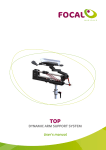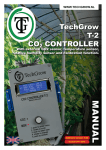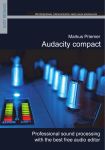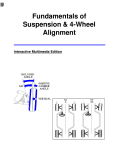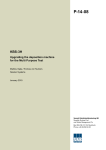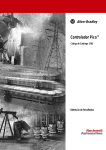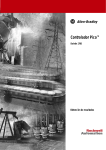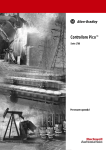Download DYNAMIC ARM SUPPORT SYSTEM User's manual
Transcript
TOP DYNAMIC ARM SUPPORT SYSTEM User's manual Contents INTRODUCTION page 2 FOR WHOM IS TOP INTENDED page 3 WORKING PRINCIPLE page 4 PARTS page 6 DESCRIPTION page 6 DESCRIPTION - MECHANICAL HELP COMPONENTS page 9 DESCRIPTION - ELECTRICAL HELP COMPONENTS page 11 MOUNTING page 13 ADJUSTING page 13 USE page 17 WARNING page 19 MAINTENANCE page 19 CE MARK page 19 WARRANTY page 20 CONTACTINFORMATION page 24 V.10.07 1 INTRODUCTION This is the USER’S MANUAL of the dynamic arm support system TOP (hereafter TOP), which can be mounted on a wheelchair, chair or table. TOP is manufactured and distributed by FOCAL Meditech, a company that specializes in the supply of high-end head and body support systems, dynamic arm support systems, robot manipulators, feeding devices and custom-made products. This manual provides information on the product, the purpose, how to use it and the consequences of using it. The goal of this information is to guarantee a longlasting, successful and effective use of the dynamic arm support. You will know what you can and can't expect of the dynamic arm support and it provides global information on how to adjust TOP as well as to what features need special attention when using TOP. In the back of the manual you will find contact information of the supplier. This manual also provides information on our HELP component. HELP (which, in Dutch, is short for ‘High And Low Positioning’) is a usually standard added component to TOP that makes it possible to support vertical movements. This information is only important for users of this extra component. Please take the time to read this information well: Profound knowledge of this aid leads to a more efficient use and yields better results. It is recom- 2 mended that this manual is also read by persons in your surroundings, for instance those that play a role in your day-to-day care! FOR WHOM IS TOP INTENDED? TOP was developed for all persons that can no longer position or use forearm and hand due to lack of muscle power or neulogical facilities. To be able to use TOP, at least some functionality in shoulderbelt and arm are required as well as some functionality of the hand (grab, manipulate). The arm support can also be used by healthy persons that often have burdening (job) positions. TOP can be deployed both single-sided and double-sided. Single-sided or double-sided use depends on a range of factors, like the user's individual limitations and possibilities and his or her needs. The user of TOP can be active in a lot of different areas, i.e. at home, at school or in a job location, in an institution or any other location. TOP can also be used therapeutically, for instance by letting the user work with an increasing reach or with resistance. The HELP component, which is almost always delivered together with TOP, facilitates vertical arm displacements that allow a user to eat and drink independently or to reach high. This component is considered to be useful for most users. Whether the dynamic arm support system is mounted on a wheelchair, chair or table also partly depends on the user's individual needs and wishes. When reading the manual please pay special attention to the instructions concerning 'safe use'. Text that is of special interest for safety is marked with a safety symbol (see example). 3 WORKING PRINCIPLE OF TOP The dynamic arm support system TOP is a system of axes with several rotation points, with an arm fitting and a connection with the 'real' world (chair, wheelchair, table or movable carriage). The forearm rests in the arm fitting allowing TOP to bear most of the weight of the user's arm and relieving the shoulder belt. Through the axes system TOP can aid conveying movements which are initiated in shoulders and arm, to forearm and hands. Dynamic arm support systems are mostly used by persons with limited muscle strength in shoulder belt or arms because of neurological or orthopaedic diseases in these parts of the body. By deploying what is left of the user's own capacities he or she can bring the hands to a 'useful' position. Reaching, grabbing and manipulating and therefore executing all kinds of daily activities are possible again. TOP operates horizontally and is not extra powered. The HELP component is usually delivered as part of TOP. This component, which is supported mechanically by means of a spring mechanism, facilitates vertical displacements. Electric empowering can be supplied. 4 TOP is characterized by a very rigid construction with high-quality bearings and with a minimal tolerance in the different axes. It operates extremely light and smooth. This light operation together with a perfect fit and extensive adjustability demands little use of force by the user. TOP has more rotation points and more motion axes - even vertically - than any other known product. This makes its movements light and smooth. The system 'follows' the user's arm perfectly and the arm doesn't 'lock-up'. TOP is highly customisable and individual adjustments are made when needed. Version with locking mechanism For users who are in need of a system that can be fixed in any given position a lockable version is available. Users can independently operate this function. The following are examples of situations where locking sometimes is desired: outdoor wheelchair driving; use during transfers. Locking is performed by the use of a switch. This switch operates a an electric locking mechanism. Locking takes place in horizontal plane and can be realised in any given position. The locking mechanism is an optional feature and can be supplied for mechanical as well as electrically powered versions. 5 PARTS DESCRIPTION Description of the parts of the dynamic arm support system TOP, topdown. •The arm fitting is located at the top of the system. The arm fitting is the part that holds the arm, it is always custommade. •At the front of the arm fitting a tilting handpalm support is usually found. This handpalm support is extensible and detachable. It's shape can be adjusted individually. •Characteristic for the tilting version of TOP is that the arm fitting is mounted on a double joint, which makes tilting possible. •The double joint is fitted with the socalled 'slide mechanism' that is used to determine the tilting point of the arm fitting. This enables changing the position of the arm fitting with respect to the double joint. 6 •The double joint is combined with the carriers of the beforementioned handpalm support and the automatic elbow support. •The purpose of the automatic elbow support is to prevent the forearm from sliding out of the arm fitting when this is tilted upwards. The automatic elbow support can also be used to limit the tilting angle of the forearm. •The so-called 'direct connecting rod' is located under the double joint. The direct connecting rod is a metal b shaft that is mounted in the bearings a of the extension arm below it. The direct connecting rod allows the arm fitting to rotate over the extension arm. A short (a) and a long (b) version of the direct connecting rod exist. When the short version is used, the arm fitting can rotate directly above the extension arm. When tilted the arm fitting could collide with the extension arm. When the long version is used this collision is prevented over a long tilting distance. •Together with the arm fitting the extension arms provide the actual horizontal support of the forearm. The base version exists of two short extension arms and one long one, which are respectively 70mm and 120mm long, but this can be changed according to the wishes of the user in order to create a maxi- 7 mum reach. All joints of the extension arms exist of shafts and bearings as described directly above. •The rotation of the extension arms can be limited by means of a synthetic plug. This plug is put into the bottom of the extension arm. Also, one or two blocking pins can be fitted in small holes which are located in the top of the extension arm below. •The lower extension arm runs into the rotation block. The rotation block is a construction that exists of two circular discs that can be rotated in respect to each other. At the top it has bearings in which the extension arm above is fitted. •Around the center hole there's a pattern of smaller holes that allow limitation of rotation. The angle under which the upper components (for horizontal movement) operate can be adjusted by means of the rotation block. This is done by changing the angle under which the arm support operates. This change can be made by turning the two discs - that have sloped edges in respect to each other. Note: when adjusting the angle one should choose between the device's assistance in a certain direction of movement and an 8 optimal resting posture in which the user's arm falls back to the body automatically. •At the bottom the rotation block is connected to a supporting structure: an adapter block that is mounted directly to the (wheel)chair or table. This adapter block is custom-made per application. If TOP has to operate vertically (with assistance of the HELP component), the rotation block is mounted on the HELP component. DESCRIPTION – VERSION WITH LOCKING MECHANISM The following description only applies to TOP users that will use the lockable version. This version has an electromotor for the activation of a mechanical locking mechanism inside specific extension arms. •External switch, light to operate. Can be positioned at any place near the user. Also switches of other brands can be applied. •Extension arms provided with a locking mechanism (a) (at the bottom) •Specific rotation block (b) with electric driving mechansim of the locking mechanism inside. a b DESCRIPTION – MECHANICAL HELP COMPONENTS The following description only matters for TOP users that will also use the HELP component. This HELP component (in short: HELP) is the part that supports the forearm during vertical movements. •HELP exists of two parallel tubes that are connected through joints (a parallellogram with variable proportions). The vertical displacement is assisted by two elastic cords that are con- c a b 9 nected to the two tubes. The cords (a) are tightly fit to the lower fixation point (b). The upper fixation point for the cords is located on a small adjustable block(c) on the upper tube. •The position of the mounting block on the upper tube can be adjusted by means of a threaded rod which is located in the upper tube (a). The mounting block is displaced when a the screw ax at the back of the upper tube is turned - please use the provided hexagonal wrench. By displacing the mounting block it is possible to tighten or loosen the cords according to the user's wishes which respectively results in an increased or decreased support in upward movements. Be advised that increased support in upward movements automatically means that more pressure is required to move down again. On the opposite less support in the upward movement requires less pressure to move down again. • HELP has an upper (a) and a lower (b) 'stop'. a b •TOP and HELP are located on a mounting tube. The mounting tube is the connection between TOP and HELP and the (wheel)chair or table. 10 •The lever for blocking HELP in the lower position is located at the front of the mounting tube. Mechanical version only. •This blocking mechanism is effected by a hook that is positioned over the lower tube. The lever enables attaching and detaching the hook. •To make operation of the lever easy and to prevent obstruction, the lever is made telescopically. The position of the upper part of the lever - when it is not extended - can be adjusted by means of an adjustment ring (a). a •Below the mounting tube you will find a specific adapter for mounting on a table, chair or wheelchair. This adapter is custommade and offers possibilities for height adjustment. DESCRIPTION – ELECTRIC HELP COMPONENTS •If the up and down movements cannot be performed adequately, the HELP component can be fitted with electrically powered vertical displacement. An electromotor with accessories is fitted at the back of HELP. This electromotor is usually operated with a separate switch. 11 •Electromotor with cover and driving mechanism (mounted together) •Switch unit with switch and fuse. The tuning of the upper stop is set electronically. In addition the supplier can alter the speed of the movements and the movement characteristics. •Switch. The electronic HELP is commonly controlled with a separate switch that is very light to operate. However, operation through a user interface integrated in the wheelchair operating system is also possible. Also various other operating methods can be realised in consultation with the supplier. 12 MOUNTING TOP After a period of extensive try-out and evaluation the dynamic arm support is mounted onto the support of choice. Mounting is individual and differs form person to person. Changing TOP to a new support or provision has to be done by an authorized dealer of the FOCAL arm support systems. ADJUSTING TOP Beware! Before adjusting TOP, all sitting elements of the (wheel) chair have to be put in the most common active sitting position. 1) Adjusting TOP requires before everything else that the perfect inclination angle for the system is determined. Use the provided hexagonal wrench to detach the two discs of the rotation block. The discs can now be turned by hand, put in the correct position and be attached again. When using the default position, the forearm has to turn slightly inwards later on. It may be needed to make some adjustments later. 2) Mount the chosen extension arms by putting them together. The height of the system can now be adjusted by means of a button that is found at the lower end of the adjustment unit. 3) Mount the double-joint onto it. 13 4) Put the user's arm in the arm fitting. 5) Determing the correct heigth adjustment by using the mounting adapter. Beware that the user's shoulders when in a resting position - are horizontally lined up as much as possible. The user's comfort plays an important role here! 6) Ask the user to make some movements to get a little acquainted with TOP. 7) When using the HELP component: Try to level the weight of the arm as much as possible in order to compensate the downforce. In order to do so adjust the tension of the cords. Follow these steps: Ask the user to lift the arm and check if this can be done without dropping or that the user has problems lowering the arm again. Adjust the tension of the cords if needed: using the provided hexagonal wrench, turn the ax a few times to tighten or loosen the cords. Right rotation gives more assistance when lifting the arm while left rotation decreases assistance. Look at the effect, and adjust the tension a little more when needed. Turn the ax back a few rotations when lowering of the arm becomes 'heavy' . 8) Position the swivel adjustment of the arm fitting. At the bottom of the arm fitting - between the two screws - a sunken bolt is located (a). This bolt fixates the sliding plate, that is connected to the arm fitting, to the double joint. By moving the 14 sliding plate, tilting the forearm will a be easier. The more the arm fitting is moved backwards in respect to the joint the easier tilting the forearm upwards will be. At some point however it will become more difficult to tilt the arm back. It is advised that a good adjustment is made with the right balance between tilting up and down. 9) The automatic elbow support should be pressed against the lower part of the arm when the forearm is tilted. Further adjust the effective angle of the support cushion through the bolt at the bottom of the cushion (a). The depth adjustment of the elbow support - i.e. the distance between support cushion and arm fitting - can be altered through the bolt that fixates the little bent rod (b) in the backside of the double joint. a b 10) The handpalm support can now be moved in such a way that the palm of the hand is supported in a comfortable way. The little cushion can either be left to tilt along with the hand or can be fixated under any chosen angle. 15 11) The horizontal movements of the extension arms can be limited if desired. This is done by putting a synthetic plug into the bottom of the extension arm. Blocking pins are then put in the pattern of holes of the underlying extension arm (or in the top of the rotation block), according to the area that has to be limited. Now, the extension arms can only rotate within the area that is limited by the pins. By limiting the rotation area of the extension arms, some improved functionality or therapeutic goals can be achieved. It also helps to avoid a traject where the user can not operate well or activates muscle groups that would be insufficiently strained otherwise. Also the function of rotation limitation can be avoiding contact between the tilted arm fitting and the extension arm. 12) Let the user try if the rotation limitation is correct and adjust the blocking pins if necessary. 16 USING TOP How TOP is used depends on individual needs and wishes of the user and by the environment in which it is used. The activities that can be undertaken with the aid of the dynamic arm support TOP are almost unlimited. Every Day Life activities consist mainly of eating and drinking independently as well as facial and dental care. Being able to reach one's head for putting on spectacles or a hearing aid are considered to be important too. Common activities are writing, using a computer, household activities, child care and nursing, playing and hobbies. However, even in such futile tasks as operating switches or daily used equipment, TOP is an indispensable asset. The mechanism of the lockable version is switched on by moving the switch into the direction of the ‘X’ sign. The locking mechanism will actually lock when the user moves his arm slightly. The system is unlocked again when the switch is moved into the direction of the ‘O’ sign. If the arm support TOP is provided with a locking mechanism the extension arms are default connected to the rotation block. To take the extension arms from the rotation block the locking pin must be removed. The HELP component is integrated into most of the TOP arm support systems. HELP provides a means for vertical displacements of the arm in all kinds of activities. Height adaptation of the electric version is performed by moving the switch into the direction of the ‘H’ (High) or the ‘L’(Low). The dynamic arm support is often found mounted on a hand-operated or electric wheelchair and on working chairs. Especially in labour situations TOP will be mounted directly to working tables. Users are known 17 to change their transport and sitting devices often. Of course it is possible to mount a dynamic arm support on every device a user has. To serve efficiency, the part that facilitates vertical displacement can be made interchangeable if this is technically and functionally possible. When the proper adjustments have been made the actual use is very simple. The arm fitting can be provided with special accessories to allow the user to perform specific tasks like writing or eating. The dynamic arm support can also be used in combination with special hand splints. 18 WARNING 1) Never unlock the HELP component when not pressed upon, i.e. without an arm in it. If done so, the arm support will jump upwards and can harm persons or damage objects. When, for example in case of maintenance, HELP has to be unlocked without the user's arm in it, please make sure to fixate the moving part with your hand. 2) The arm support may never be used as support to lean on or to get upright. During evaluation it should be accounted for that the user sits stable and that it is possible for him or her to come into an upright position without leaning on the arm support. MAINTENANCE Not much maintenance is required for this dynamic arm support. The device can be cleaned with a moist cloth and a non-aggressive cleaning agent. Strong heating of the arm fitting, for instance by putting it on a central heating or in direct sunlight, should be avoided. CE MARK This product was CE approved and complies with European regulations for medical aids. 19 WARRANTY GENERAL These guarantees are part of the General Conditions of FOCAL Meditech. In the Warranty, the provisions in the General Conditions are to be respected. The following warranty terms are based on EU Directive 99/44/EC and the Dutch Civil Code. The marketing and use of medical devices are also specified in Directive 93/42/EEC and Royal Order 243 of March 30th, 1995. The resulting rights remain unaffected, as well as the warranty from the dealer to the end user. Warranty Terms and Conditions may be extended or modified if they are in writing and in compliance with the law. Our products are produced and assembled with the utmost care. However, certain product defects can occur. At request, FOCAL Meditech will repair all defects, both inside and outside, during the warranty period. This guarantees that the product life span is not negatively affected. WARRANTY PROVISIONS The warranty for this product is according to the following conditions: Article 1 We will rectify, free of charge and subject to the conditions 2 to 14, all product defects that are manifest within 24 months from the date of delivery to the end user. In the case of professional or equivalent usage, the guarantee is limited to 12 months. The guarantee for used products is also limited to a period of 12 months. Article 2 Our guarantee means that the product will be returned in the same condition it was in before the defect occurred. FOCAL Meditech decides whether defective parts are repaired or replaced. Parts that are replaced without charge will become our property. 20 Article 3 The defect must be reported immediately to prevent possible further damage. The warranty is void if the defect is NOT reported within two months after determining the defect. Article 4 To invoke the warranty, the personalized sales receipt or proof of delivery or purchase must be submitted. In case these are not available, other convincing evidence should be submitted. Article 5 The warranty does NOT cover small deviations from the prescribed quality, such as, but not exclusively, deviations in measurement or size which are insignificant for the value, suitability or functionality of the product. Article 6 The warranty does not cover damage caused by improper or incondiderate use or use for other uses than the product was designed for. Article 7 The warranty does not apply when damage is caused by: 1)Chemical and electro-chemical influence of water or other liquids. 2)Abnormal environmental conditions in general. 3)Operating conditions which are unsuitable for the product, e.g. unusual pressures and accelerations. 4)Contact with aggressive substances. 5)Neglect. 6)Any other external cause from outside, for instance bumping or collision. Article 8 Warranty does NOT cover malfunction because of damage sustained during transport and beyond the responsibility of FOCAL Meditech, 21 installation or assembly by non-qualified persons, poor or inadequate maintenance, or ignoring the instructions. Article 9 Warranty is void if the defect was caused by repair or interventions by third parties that are not qualified or skilled, or if the product is fitted with accessories or parts that are not original. The warranty also expires if marks or serial numbers have been removed. Article 10 Repair on site within 14 days will be pursued. However repair on site can only be required in the case of a minor problem, to be determined by the supplier. Transportation of the device to a workplace or the manufacturer may be required. Article 11 If, during the warranty period, repair of the same defect fails repeatedly or the repair costs are disproportionate, an equivalent replacement is provided in consultation with the user. In case of replacement, we reserve the right to charge a fee in accordance with the elapsed time of use. Article 12 Repair under warranty does not extend the guarantee or warranty or the start of a new period except for the part of the product that was repaired. FOCAL Meditech provides a warranty period of 12 months, limited to the particular defect. Article 13 Necessary or desirable adjustments are not part of the standard product, as documented in the manual. FOCAL Meditech will try to deal with failures of individual adjustments in accordance with the provisions of the standard product warranty. Necessary or desirable individual adjustments do not form part of the warranty. 22 Article 14 Claims of the purchaser under a warranty are not transferable to third parties. This warranty covers products that are bought and / or in-service in the Netherlands. If a product is marketed abroad, the user must check whether the conditions there (e.g. voltage, climatic conditions) are in accordance with the established operating conditions. In the case of resale, the reseller should provide guarantee. FOCAL Meditech attaches great importance to the functioning of its products, which tend to serve persons with significant limitations. Consultation about defects or malfunction of the product due to factors not described in the warranty is highly recommended. The service facilities of FOCAL Meditech are always available to the user, even when the warranty has expired. 23 CONTACT INFORMATION The dynamic arm support TOP and the HELP component are manufactured by FOCAL Meditech BV Droogdokkeneiland 19 5026 SP Tilburg The Netherlands. Phone: +31 (0)13 533 31 03 Fax: +31 (0)13 533 50 04 E-mail: [email protected] Internet: www.focalmeditech.nl The dynamic arm support TOP and the HELP component are delivered by 24 FOCAL Meditech BV Droogdokkeneiland 19 5026 SP Tilburg Nederland T +31 (0)13 533 31 03 F +31 (0)13 533 50 04 E [email protected] I www.focalmeditech.nl




























